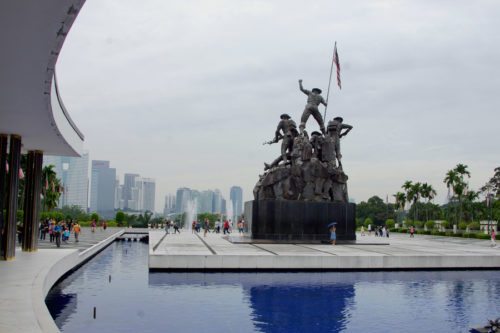I’d have been happy spending several days just wandering around Chinatown but its a shame to not make the effort to see the rest of a city.
Tourists at the Kings Palace
A morning tour took us to the traditional tourist photo stops.
We started at the Kings Palace, Istana Negara, on Bukit Petaling overlooking the Klang river.
This is popular with tourists and locals. Originally it belonged to a Chinese millionaire then it became the official residence of the king until 2011 when he moved to a new luxurious palace.
You can’t go in but the gates a very attractive and the guards are happy to let tourists take photos with them.
The War Memorial
The war memorial, Tugu Negara, is classed as a national monument.
It honours the fallen in Malaysia’s struggle for freedom against the Japanese in World War Two and in the Malaysian Emergency. I’m a bit hazy about the explanation of this but it appeared to be a communist plan to gain power in SE Asia. It was fought between the Malaysian National Liberation Army and the Commonwealth forces between 1948 and 1960 . This seems to me to be a very long time to be fighting and our guide who lived through it was remarkably sanguine about it.
This monument is the worlds largest free standing sculpture group – something to add to the list of the worlds tallest, longest reclining, standing, sitting, praying Buddha, stupa, temple or mountain.
The National Mosque
On to the National Mosque, the Masjid Negara. This national symbol of Islam is next to the old railway station. It was built when Malaysia and Singapore split in 1965 and can hold 15,000 worshippers.
The roof is stunning. Its eighteen point dome represents the thirteen states of Malaysia plus the five pillars of Islam.
Batu Caves
Now for an afternoon out of Kuala Lumpur to visit the 400 million year old Batu caves.
The short journey starts from Sentral Station where you get the commuter train to Batu about seven miles north of Kuala Lumpur.
There are three main limestone caves which were discovered in 1892.
At the bottom you see the giant statue of Murugan a Hindu deity. He is made of concrete and covered in 300 litres of gold paint. I do love a bit of useless information!
You climb 272 steps passing lots of macaques looking for food as you go. At the top you will find the largest cave called Cathedral which is sacred to Hindus.
Further down is Dark Cave, a network of caverns but you need a guide to enter and there wasn’t one available when we were there.
But Ramayana Cave is the most fun. It contains dioramas of the life of Lord Rama and includes a sleeping giant.
A Malaysian It’s a Small World!

















